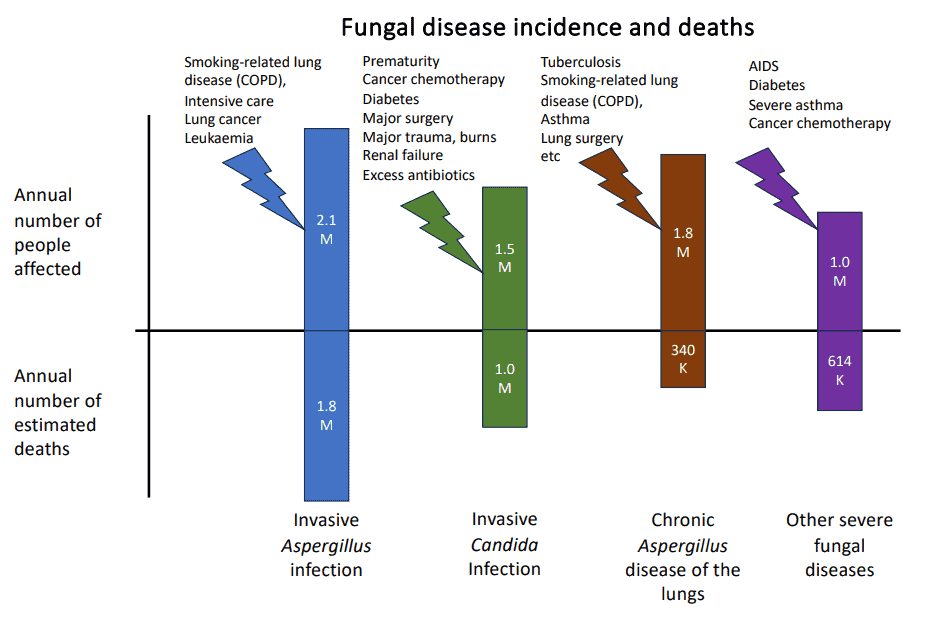Increased Fungal Infections: A Consequence Of Global Warming

Table of Contents
The Impact of Rising Temperatures on Fungal Growth
Increased global temperatures are creating more hospitable environments for the proliferation of fungi. Many fungal species thrive in warmer conditions, leading to a significant expansion of their geographical range and an overall increase in fungal infections.
Optimal Temperature Ranges for Fungi
Fungi, unlike humans, often have optimal growth temperatures significantly higher than what is considered comfortable for humans. This means that even a seemingly small increase in average global temperatures can have a dramatic impact on fungal populations.
- Aspergillus species: Many species within this genus, responsible for aspergillosis, thrive in temperatures ranging from 25-37°C (77-99°F). Warmer temperatures expand their habitable zones.
- Candida species: These yeasts, responsible for candidiasis (thrush and other infections), also benefit from warmer conditions, with optimal growth occurring at temperatures around 37°C (99°F), the human body temperature. Increased ambient temperatures can accelerate their growth and spread.
- The geographical range of many pathogenic fungi is expanding due to warming climates. This means that infections previously confined to tropical or subtropical regions are now appearing in previously unaffected areas with temperate climates.
Humidity and Precipitation Changes
Changes in precipitation patterns and increased humidity significantly contribute to the proliferation of fungal infections. Moisture is crucial for fungal spore germination and growth.
- Increased rainfall and humidity provide ideal conditions for fungal spores to germinate and grow, leading to increased fungal biomass.
- Regions experiencing more frequent and intense rainfall, often associated with climate change, see a corresponding increase in fungal-related illnesses.
- Flooding events can create stagnant water sources, perfect breeding grounds for various fungi.
Increased Exposure to Fungal Spores
Climate change is not only making conditions more favorable for fungal growth but also increasing human exposure to fungal spores.
Changing Weather Patterns and Spore Dispersion
Extreme weather events, such as hurricanes, floods, and wildfires, significantly impact spore dispersal. These events can create powerful air currents that carry fungal spores over vast distances, leading to increased exposure in previously unaffected areas.
- Strong winds associated with extreme weather events can transport fungal spores over hundreds of kilometers.
- Air currents can carry spores to higher altitudes, increasing the potential for widespread dispersal.
- Displaced populations following such events are often more vulnerable to fungal infections due to compromised living conditions and weakened immune systems.
Agricultural Practices and Fungal Growth
Intensive agricultural practices can inadvertently contribute to the rise in fungal diseases.
- Monoculture farming creates large areas with uniform conditions, ideal for fungal colonization.
- The overuse of pesticides and herbicides can disrupt the natural balance of microorganisms in the soil, potentially favoring fungal growth over beneficial microbes.
- Changes in crop yields and patterns due to climate change can affect fungal populations, resulting in higher disease incidence.
Weakened Immune Systems and Increased Susceptibility
Climate change also indirectly contributes to increased fungal infection rates by weakening immune systems.
Heat Stress and Immune Suppression
Prolonged exposure to high temperatures can lead to heat stress, which negatively impacts immune function. This makes individuals more susceptible to various infections, including those caused by fungi.
- Heat stress reduces the activity of immune cells, making the body less effective at fighting off fungal pathogens.
- Elderly individuals and those with pre-existing conditions are particularly vulnerable to the combined effects of heat stress and increased fungal exposure.
- Immunocompromised individuals, including those with HIV/AIDS, cancer, or undergoing organ transplantation, are at significantly higher risk.
Malnutrition and Increased Vulnerability
Climate change impacts on food security can lead to malnutrition, further compromising immune function and increasing susceptibility to fungal infections.
- Nutrient deficiencies weaken the immune system, making individuals more vulnerable to various infections, including fungal diseases.
- Food insecurity, often exacerbated by climate change impacts, disproportionately affects vulnerable populations, increasing their risk of fungal infections.
- Malnutrition impairs the body's ability to effectively fight off infections, leading to more severe outcomes.
Conclusion
The rise in fungal infections is a complex issue with significant implications for global health. Rising temperatures, increased humidity, altered weather patterns, and weakened immune systems are all contributing factors, creating a perfect storm for the proliferation of fungal diseases. Understanding the link between climate change and increased fungal infections is crucial. We need further research to better understand the mechanisms and develop effective strategies for prevention and treatment. Furthermore, global action to mitigate climate change is essential to reduce the risk of increased fungal infections and protect vulnerable populations. Let's take action to mitigate global warming and protect ourselves from this emerging threat.

Featured Posts
-
 Andalusian Farmstay Escape Your Peaceful Country Retreat
May 26, 2025
Andalusian Farmstay Escape Your Peaceful Country Retreat
May 26, 2025 -
 Hoka Cielo X1 2 0 Review Speed Comfort And Performance Assessment
May 26, 2025
Hoka Cielo X1 2 0 Review Speed Comfort And Performance Assessment
May 26, 2025 -
 Le Palais Des Congres De Liege Apres Le Depart De La Rtbf Un Nouveau Chapitre
May 26, 2025
Le Palais Des Congres De Liege Apres Le Depart De La Rtbf Un Nouveau Chapitre
May 26, 2025 -
 Ovde Penzioneri Uzivaju Luksuz Skupe Vile I Bogatstvo
May 26, 2025
Ovde Penzioneri Uzivaju Luksuz Skupe Vile I Bogatstvo
May 26, 2025 -
 Rangkaian Balapan Moto Gp Inggris Jadwal Terlengkap
May 26, 2025
Rangkaian Balapan Moto Gp Inggris Jadwal Terlengkap
May 26, 2025
